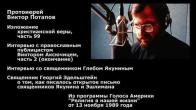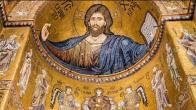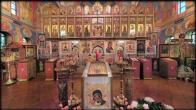You are here
Hiero-confessor Athanasius (Sakharov), bishop of Kovrov
October 15/28
 Archbishop Athanasius was among the last directors of that part of the Russian Orthodox Church which, canonically remaining true to Metropolitan Peter, Patriarchal locum tenens, separated itself from Metropolitan Sergius and went into the catacombs.
Archbishop Athanasius was among the last directors of that part of the Russian Orthodox Church which, canonically remaining true to Metropolitan Peter, Patriarchal locum tenens, separated itself from Metropolitan Sergius and went into the catacombs.
After the All-Russian Local Church Council of 1945, the then-imprisoned Archbishop Athanasius Sakharov and those of like mind with him recognized His Holiness Patriarch Alexis, and entered into canonical communion with him.
The future Holy Hierarch Athanasius was born into the pious family of Gregory Sakharov, a court counselor, on July 2 (O.S.), 1887, in the village of Tsarevka in Kirsanov District, Tambov Province. At Baptism, he was named Sergius, in honor of St. Sergius of Radonezh. He spent his childhood and youth in Vladimir. His mother managed to instill in him from early youth a love for the Lord. Sergius’ father had died when the child was but 1½ years old. Matrona would often tell her son that she dreamed of his dedicating himself to God’s service.
Sergius would eagerly attend the parish church, never wearying of the lengthy divine services. From early childhood, he felt that he was a servant of the Church, and would even tell his companions that he would become a bishop. Although Sergius did not find his years of primary school easy, he was successful in his later studies: from 1896 to 1902 in the Shuisky religious school, and then at the Vladimir Seminary. In 1908 he enrolled in the Moscow Theological Academy, from which he graduated in 1912 with the degree of Candidate in Theology.
Sergius’ first teacher and spiritual instructor was Archbishop Nikolai (Nalimov) of Vladimir. Later Bishop Fyodor (Pozdeevsky), a noted theologian, strict ascetic, and rector of the Moscow Theological Academy, became his teacher; on October 12, 1912, in the Church of the Protection of the Mother of God, he tonsured Sergius into monasticism with the name Athanasius, in honor of the Patriarch of the Imperial City. On October 14, 1912 Vladyka Fyodor ordained Monk Athanasius a hierodeacon, and on October 17 of the same year, a hieromonk. The very same year, Hieromonk Athanasius was assigned to teach pastoral theology, homiletics, and liturgics at the Poltava Theological Seminary; he held that post until 1918.
In 1917, Hieromonk Athanasius was selected to be a member of the All-Russian Church Council; he took an active part in its work as a member of the Liturgical Committee. After the Council established the Feast of All Saints Who Shone Forth in the Russian Land, he co-authored (with the noted academician and orientalist B. A. Turaev) the services for that Feast.
On January 20, 1920, he was elevated to the rank of Archimandrite, and on June 27, 1921, at the Nizhegorod Monastery of the Exaltation of the Cross, was consecrated Bishop of Kovrov, Vicar Bishop for the Diocese of Vladimir.
One year after his consecration, Vladyka was sentenced, for the first time, to exile to the Zyryansk Region. On March 18, 1922, he was released, but on March 30, Great Wednesday, was re-arrested. Together with other bishops, he was charged with resisting confiscation of church valuables, and was sentenced to one year of incarceration; on May 28, 1922 he was granted amnesty. On July 15, 1922, he and Bishop Seraphim of Murom were arrested; on July 25, 1922 he was released. On September 10. 1922 he was re-arrested, and sentenced to two years’ exile to the Zyryansk Region.
On April 12, 1925, he took part in Patriarch St. Tikhon’s funeral. He signed the Act transferring supreme ecclesiastical authority to Metropolitan Peter (Poliansky) of Krutitsa. On September 8, 1925, while traveling through his diocese, he was again arrested. During the period 1925 – 1933 Vladyka was arrested several times, and after being convicted, served terms in the Solovki Islands and the Turkhan Region. In 1933 he returned to Vladimir. Vladyka considered his difficult years of incarceration not as a loss but as an acquisition. His periods of life at liberty were very brief, but amazingly rich in archpastoral activity and spiritual labors. For a time after his first terms of exile, Vladyka lived in Staraya Rus’. Then he settled in the village of Petushki in Vladimir Province. Many of the orphaned children of the (now glorified) Alexis and Sergius Metchev came under his direction there.
During those years, Vladyka Athanasius served the Liturgy in the apartments of his spiritual children. While living in Petushki, Vladyka would receive hundreds of letters; he kept up a correspondence not only with his spiritual children, but with many of those with whom he had been imprisoned. He would send packages to those in need of assistance and comfort. One of the bishops with whom Vladyka corresponded was Bishop Zinovy (Mazhuga), later a metropolitan, who once told his spiritual children, “Children, if you only knew who lives right next to you! Be afraid of offending that person, whether by your words or even by your facial expression! He is one of the great ones. There are none like him left!”
The Elder’s spiritual children would relate that Vladyka Athanasius in all of his dealings with others, he was always frank and attentive, that he treasured even the slightest service rendered to him, and that he always strove to express his thanks for it. He himself loved doing good only to the glory of God. The Elder often reminded his spiritual children that talents are a gift from God and that one must never take pride in them. Once, in answer to the question “How can one be saved?” he answered, “The main thing is faith. Without faith, the very best of works are not unto salvation, for at the foundation of everything is faith. The second thing is repentance. The third is prayer, the fourth, good works. And despair is the worst of sins.” Vladyka advised, “As soon as you are conscious of having sinned, cleanse your soul with tears.”
The Elder’s spiritual children would relate that his prayer was so powerful that many of the faithful would quickly be helped by his prayers. Vladyka would hide the fact of his clairvoyance, revealing it only on extremely rare occasions.
At the beginning of the Great Patriotic War [World War II], Vladyka was once again arrested, and was sent on foot to a camp on Onega, in Arkhangel Province. Famine and the difficulty of the journey so weakened Vladyka that he seriously prepared himself for death… Life in the camps on Onega was replaced by an indefinite term of exile in Omsk Province, where Vladyka worked as a garden night watchman in one of the communal farms near the town of Golyshmanovo. Later he was transferred to the town of Ishim, where he subsisted on what was sent to him by friends аnd spiritual children.
Here are some excerpts from Vladyka’s letters to spiritual children: “According to what was revealed to a certain person of great spiritual life in Moscow in the years 1917 – 1918, the Prophet Elias is a bringer of nourishment for our times, as he was a bringer of nourishment to the widow of Zarephath. Metropolitan Kirill told me that he learned about this from Archbishop Fyodor, with whom he shared a cell in Taganka. According to the Most Reverend Fyodor, [the monks of St. Daniel’s Monastery] began to commemorate the Prophet Elias every day, and during the famine did not experience any want. Metropolitan Kirill also began to commemorate the Prophet, and he as well did not experience want. On July 20, he unexpectedly received so many parcels that the crew of ruffians that brought the parcels and of course got their abundant share of them, put up a sign saying “Produce Warehouse” on the doors of the cell housing the Most Reverends Kirill and Fyodor.
Following Metropolitan Kirill’s example, every day after the evening meal, I also read the troparion to the Prophet, in a somewhat amended form, as you can see in my “Liturgical Experiences.” I firmly believe that by the intercession of the Prophet and Nourisher, the Lord continues to feed me, through kind people who for me are that small measure of flour and that little vessel of oil that did not run out for the widow throughout that entire famine, just as the Prophet had told her. I believe that through the intercession of the Prophet, the Lord will feed and nourish as well those who feed others in Christ’s name.”
In the winter of 1942, Bishop Athanasius was unexpectedly transferred to Moscow. The judicial proceedings lasted half a year. He was questioned about 30 times, usually at night. Sometimes four hours of questioning would result in only one page of minutes, and sometimes, would yield over 10 pages… Not once during those interrogations did Vladyka ever betray anyone else, or ever confess to any (crime) himself. However, this sentence was announced: Eight years of incarceration in the notoriously cruel Mariinsk Camps of Kemerovo Province.
Vladyka Athanasius wrote, “As to the future fate of monasticism, it was revealed that the last of the monks would live like lay people, but that their spiritual struggles would be equal to those of the ancient fathers. That was said of our times. We are poor monks, we are always in a worldly setting, we have worldly thoughts and take worldly actions. However, the fact that in these evil days, with all our weaknesses and sins, we are not ashamed of our Christian vocation and of our monastic rank – that alone, I believe, will be seen as a spiritual struggle equal to that of the ancient desert-dwelling fathers. The only thing is that, at the same time we must also have within us two qualities: humility and love. In our hearts there must not be even a trace of malice or enmity, even towards our enemies. Carry the weaknesses of the weak, and do not please yourselves.”
In the summer of 1946, Vladyka was once again transferred to Moscow for a new investigation stemming from a false accusation made against him. Shortly thereafter, the accuser disavowed his assertions, and His Grace was sent to the Temnikov Camps in Mordovia to serve out his term. He was already so physically weak that he was relegated to making lapti [a type of plaited footwear]. Two years later, Vladyka was shipped to Dubrovlag, also in Mordovia, where on account of his age and state of health, he could no longer work.
On November 9, 1951 the 64-year-old hierarch completed his final term in the camp tollhouses. But even then, they kept him completely ignorant as to his future fate, and later forcibly settled him in a retirement home in Potma, Mordovia, where the routine was not much different from that in the camps. Finally, on March 7, 1955, Bishop Athanasius was released from the Potma retirement home. Vladyka decided to live in the village of Petushki in Vladimir Province.
In the late 1950s, reminiscing about the period of his life as a Confessor, Vladyka Athanasius noted that he had spent “33 months in diocesan service, 32 months at liberty but not in service, 76 months under banishment, and 252 in bondage and bitter servitude.”
To summarize Vladyka Athanasius’s principal [published] works:
- The Service to the Synaxis of All Saints Who Have Shone Forth in the Russian Land.
- The Synodicon of the Church of All Saints Who Have Shone Forth in the Russian Land. For the Repose.
- Commemoration of the Reposed According to the Ustav of the Orthodox Church.”
- Magnifications and Selected Psalms for the Feasts of the Lord, the Theotokos, and the Saints, Chanted in Churches Dedicated to Them, or Wherever They Should be Celebrated with a Polyeleos.
- “Moleben for the Homeland.
During his incarceration, Vladyka composed Molebens “For Those in Sorrow and Various Circumstances,” “For Enemies, For Those Who Hate and Wrong Us,” “For Those in Prisons or in Confinement,” “For Thanksgiving on Receiving Mercy,” “For Cessation of Wars and For Peace of the Entire World…” It was there, behind prison walls, that “The Service to the Synaxis of All Saints Who Have Shone Forth in the Russian Land” was finally completed, after [Vladyka Athanasius’s] consultations with hierarchs incarcerated along with him. Among those hierarchs was Archbishop Thaddei of Tver, glorified by the Church as a Hieromartyr. Thus, on November 10, 1922, in cell 172 of the Vladimir Prison, the corrected service to All Saints in the Russian Land was first celebrated.
- The Service “Celebration of the Most-holy Theotokos’ Holy Icon, Known as the Maximov Icon.”
- Prayers at Meals.
Vladyka Athanasius collected and edited texts of services to Russian saints, and worked to formulate a Russian Typicon. As an expert on the Divine Services of the Orthodox Church, Bishop Athanasius worked beginning in 1955 as Director of the Liturgical Calendar Committee at the Publication Department of the Moscow Patriarchate, and made substantial corrections in the Menaion of the Saints.
The writer Sergei Fudel, a contemporary of the Holy Hierarch, recollected that in the bishop’s cast of mind what was attractive was not so much the marks of strict traditionalism and correct observation of the ustav, as an unstoppable outpouring of love for his neighbor, a love that, transcending convention, streamed forth from him unconditionally. He wrote that more than once he had wanted “to fall to his knees before the Elder, seeking after… his unfailing courage and unquenchable warmth.”
In August 1962, Vladyka Athanasius began to prepare his spiritual children for the fact that he would soon die. Hearing them say that they would not be able to stand to part from him, he sternly remarked, “How can you be so attached to a person? By so doing, we violate our love for the Lord. After all, you are not left alone; you remain with the Lord.”
By October 26, Vladyka had become so weak that he could no longer speak, but on Friday night he quietly said for the last time, “Prayer will save you all!” Then, on the blanket, he sketched the words “Save, O Lord!” [Thank you!]
As he had earlier prophesied, on October 28, 1962, Vladyka Athanasius quietly gave up his soul to God.
The Most-reverend Athanasius was interred in Vladimir, at the Vvedensky Cemetery.
On learning of the repose of the Confessor of Christ, Elder Kuksha [since canonized as a saint] of the Odessa Monastery said, “The time will come when Vladyka is glorified among the ranks of Saints.” That prophecy came to pass in the year 2000.
Relics in cathedral - monthly calendar
| S | M | T | W | T | F | S |
|---|---|---|---|---|---|---|
|
|
|
|
1
|
2
|
3
|
4
|
|
5
|
6
|
7
|
8
|
9
|
10
|
11
|
|
12
|
13
|
14
|
15
|
16
|
17
|
18
|
|
19
|
20
|
21
|
22
|
23
|
24
|
25
|
|
26
|
27
|
28
|
29
|
30
|
31
|
|
PARISH LIFE
Address of our Cathedral
While all the materials on this site are copyrighted, you may use them freely as long as you treat them
with respect and provide attribution on the Russian Orthodox Cathedral of St.John the Baptist of Washington DC.









